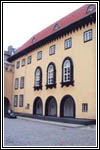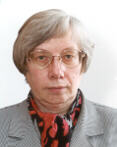 |
Vol 2, No 13
3 April 2000 |
|
|
 A M B E R C O A S T:
A M B E R C O A S T:
Does Estonia Have a Left? Mel Huang Estonia's political map is a strange creature. It seems no one wants to be firmly on the left wing. Established left-wing parties move further and further to the centre, while those remaining in the left wing shudder at being labelled "left." The press is dominated by centre-right views, as the left-wing press is downgraded into tabloid style by the powers that be. So, does Estonia have a viable left wing or not? By default, the answer has to be yes. However, looking at election results, the picture painted is that of a rather weak left-wing, compared to the right. Examining the shrinking electorate and continuously decreasing turnout, it is very likely that a portion of the voters are being alienated for their political views, which would be considered very mainstream in most European countries. Why is this the case in Estonia and not in other countries in the region? The odd coalition
Nevertheless, they have not managed to invent a magical formula of the three political philosophies, far from it. Before Tony Blair starts worrying about a William Hague Home Office or a Charles Kennedy Exchequer, the formula used in Estonia is not really representative of the three varying political ideas - but merely their tools, that is, the parties themseleves. In reality, the overall programme of the coalition is more of a compromise, heavily tilted in one direction. Even in disputes of an obvious nature, one side seems to be winning many of the intra-coalition tiffs. Many political observers see the elimination of the corporate income tax in 2000 as a symbol of this intra-coalition tilted balance. Eliminating such taxes for reinvestment was a cornerstone of the liberal platform, that is of the Reform Party platform. On the other hand, the nominally social democratic Mõõdukad complained about less funds being available for social spending through such a move but lost their fight against their laissez faire partners. From this and other examples it is clear that the liberal agenda is receiving more attention than that of the Social Democrats.
However, the current battles over VAT (value-added tax) on heating, as well as longer-term issues such as the second phase of pension reform, could spark a long-awaited challenge. Some political commentators suggest that this could break the coalition, though this seems unlikely. All three parties have sufficient interest to stay in power together, especially with the looming presidential election next year. However, the specific repositioning of the focal point among these three parties will be best indicated by which particular side caves in on this issue. A collapse of the government is unthinkable for the coalition, as it could involve the rise of the much-disliked head of the opposition, Edgar Savisaar. The Savisaar factor Edgar Savisaar is a passionately liked or a vehemently hated individual and polarises the Estonian public more than anyone. As leader of the Centre Party (Keskerakond), Savisaar has led his party simultaneously to two consecutive electoral victories and defeats, winning the most seats in the Riigikogu and the Tallinn City Council but being locked out of both. Many parties announced before the elections that they would not enter into any coalition with the Centre Party, indicating the extent of passionate feelings conjured up by the former transition-era premier. Many remember when Savisaar was last in government as interior minister, when he was implicated in a massive scandal that led to his resignation. When tapes of secret recorded conversations between powerful politicians were unearthed, the so-called "Estonian Watergate" dominated the press. Savisaar has been shut out of power since. However, Savisaar does bring in a lot of votes for his party, and his party is consistently the largest vote-winner in elections - albeit not a large enough one to rule each time. There appears to be a core 20 to 25 per cent of the electorate that supports Savisaar, coming from the usual centre-left electoral base: social activists, middle and lower-middle class, labour, the disenfranchised and others. In other words, simply the standard constituency for a normal social democratic party. However, Savisaar also counts on the support of some minority groups, law enforcement officials and others. The Centre Party usually votes alongside the largely rural Estonian People's Union (Eestimaa Rahvaliit), the Coalition Party (Koonderakond) of the now ineffectual nomenklatura, and the Russophone United Peoples Party (Ăśhendatud Rahvapartei). It would seem that, with a lack of a credible social democratic force in Estonia, the Centre Party would fill the void readily.
Often Savisaar does not help his own cause. A great example of this came during the campaign season in 1999. Savisaar, criticised often as a "big brother" figure (especially after the taping scandal), added to this hysteria with the party's campaign ads during the last parliamentary election. All over Estonia there appeared billboards showing only Savisaar's eyes behind his glasses, with the slogan, "The Centre Party knows the solutions." Many were shocked by the brazen ads, which fuelled further passions against the ever-intrusive Savisaar (see Amber Coast, "The Final Stretch, 22 February 1999, for more about this strange ad campaign). Though it was a comic relief when a cable television company replaced the ads on election day with two exposed breasts in the same style, sadly, the involvement of several prominent members of the party in alcohol-related scandals in the summer of 1999 did not help the party's image (see Amber Coast, "Hitting the Bottle, and the Road", 2 August 1999, for a sobering account). Distrust even exists amongst the politicians who support Savisaar, as evidenced by the presidential election of 1996. In the mass electoral college, the first round gave Savisaar's candidate, MP Siiri Oviir, just 25 votes - embarrassingly less than the unknown Tartu University professor Enn Tõugu, who received 47 (out of 372 members). Many saw Oviir as a stooge for Savisaar, thus even the prospects of electing a female president did not suppress the anxiety over a Savisaar-controlled presidency. As long as Savisaar remains in the party's leadership, it appears this lost electorate will stay away from the party. Instead of taking full advantage of the fleeing Mõõdukad voters, the Centre Party is, instead, building its support around Savisaar. However, the amount of strength and support lost if Savisaar goes compared to the possible gains is not certain. In the end, regardless of interpretation, the centre-left is left with a massive void. The media
Until recently, there was a small third daily that tried to challenge the pair: Sõnumileht. Though never coming close to the circulation of the two majors, Sõnumileht offered the only left-leaning editorial board among mass-circulated dailies. However, as Estonia's "independent" media is owned by two major interest groups - Sweden's Bonnier (which owns the group that publishes Eesti Päevaleht) and Norway's Schibsted (which controls the publisher of Postimees) - Sõnumileht fell victim to the gigantic Nordic media business and its fierce competition. Owned by Schibsted, Sõnumileht was soon made into a tabloid to compete against Õhtuleht - a yellow-paper tabloid with wide readership published by the Bonnier side. In fact, via its business paper Dagens Industi, Bonnier also controls Äripäev.
A viable left wing? Estonia has a left wing, but there is little unity and strength among it. The two major parties that fit the centre-left bill fail to deliver the goods. Mõõdukad has been sidelined in the ruling coalition, and many criticise the party of backing away from its social democratic roots. It has not even adopted a Tony Blair-like "third way." The Centre Party, especially its Savisaar-oriented leadership, remains problematic and for the time being, is far from the possibility of attaining large number of left-leaning voters. More exposure could be shifted to the left wing if current right-wing parties begin to falter. Though the conservative Pro Patria Union has a large contingent of loyal voters and is gaining popularity among the young and the new citizens of ethnic Russian origin, the liberal Reform Party is not in such good shape. With
There is plenty of time for the situation to change before the next set of elections, with local elections due in 2002 and Riigikogu elections in 2003. There is also plenty of time for a centre-left media to expand, with a natural market niche waiting for entrepreneurial media tycoons to give it a red banner similar to ones available throughout Europe. Mel Huang, 30 March 2000 Archive of Mel Huang's Amber Coast series of articles Related Links: Centre Party (Keskerakond) [in Estonian only] People's Party Mõõdukad (Rahvaerakond Mõõdukad) [in Estonian only] Reform Party (Reformierakond) [in Estonian only] Pro Patria Union (Isamaaliit) [in Estonian only]
|
|
![]()
Copyright © 2000 - Central Europe Review and Internet servis, a.s.
All Rights Reserved



